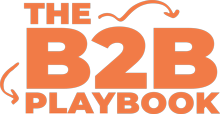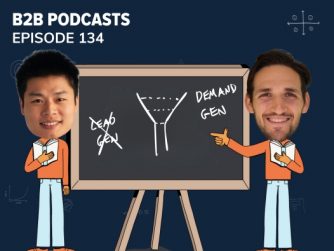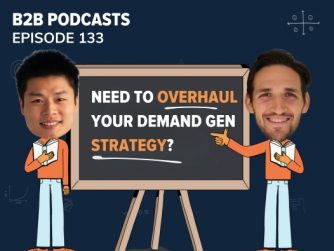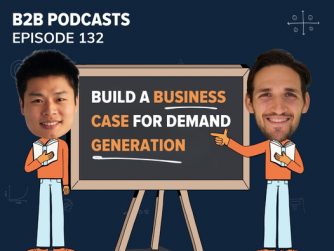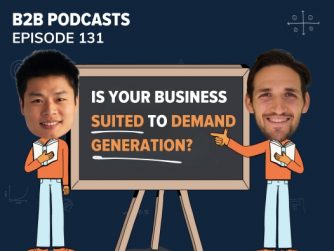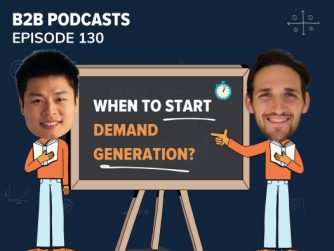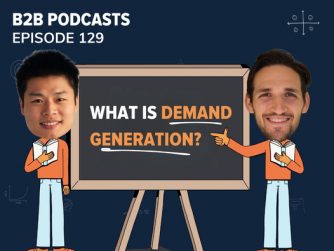As marketers, we’re often tasked with driving leads to feed the sales funnel. While this is an essential function, this narrow focus often overlooks the entire buyer journey – from initial awareness through to renewal and expansion.
By not examining how your leads progress in the pipeline, and what they’re like as customers, you could be costing your business BIG time. That’s why our recent podcast guest Adem Manderovic is calling for marketers to get back their ‘commercial acumen’, to drive business outcomes, not just leads. He shares his framework for this (called Closed Circuit Selling) which we detail below.
Listen To The Episode
Watch The Episode
Better B2B Marketing: Focus on Commercial Outcomes, not just Leads
I was initially drawn to Adam because of his deep focus on commercial outcomes, not just leads. For those of you that follow our content, you’ll know this aligns with our own 5 BEs Framework for demand generation.
His Closed Circuit Selling framework deeply resonated because it ties revenue generation to a complete understanding of the customer across their entire journey with a company. As Adam explained,
“It doesn’t really matter how good your go-to-market strategy is after they’ve decided to make the purchase, if everything falls off and they become like a churn mitigation.”
Adem Manderovic – The B2B Playbook [00:06:29]
He stressed that marketers need to look at the “full buyer decision, including AFTER the buying decision.”
Sales & Marketing Alignment: The Core Issue
The problem is both sales and marketing have become misaligned and are not addressing the full journey. Their roles have been split out over time, so neither properly address the full journey.
Marketing is asked to provide “no intent lead gen so that they can pump the amount of contacts to hit the meeting target for the customers.” Meanwhile, sales pitches focus exclusively on product benefits without addressing “customer pain points and known objectives.”
Closed Circuit Selling bridges this gap by “bringing the objectives and putting them at the top of the funnel and throughout.” It truly links sales and marketing to what ultimately drives revenue – satisfied customers who expand.
This expanded perspective reveals gaps in “commercial acumen” on both sides. Marketers must build journeys spanning brand awareness to loyalty and share hard-won insights on objections. Likewise, sales must consult on contracting, implementations and handoffs to success – not just demos. Companies that take an end-to-end approach achieve higher renewal, expansion and referrals.
Catalogue the Full Market for Insights
Adem shared a fascinating tactic for understanding customer needs, objections and buying signals – cataloguing the total addressable market by phone.
Understanding Why You Nailed Your Current Customers
He recommends calling up current customers and asking questions to find out why they get so much out of your product or service, and why they’re such a great fit. For a great list of questions to ask, check out the full list here in our conversation with customer research expert Ryan Gibson.
Understand the Deals You Didn’t Win
For lost deals, asking “Why didn’t you buy from us? What could we have done better?” [00:25:41] exposes the real barriers that blocked the deal. Even if pricing or legal ruled you out, understanding the root objection provides useful intel.
Understand Why You Lost Your Churned Customers
For customers that churned, he suggests asking:
- “why did you originally buy from us?
- “why did you leave?”
- “were there any other objections that you didn’t actually tell us? Just so that we can be better for next time.” [00:25:41]
This reveals the original motivations to buy and any unaddressed issues that caused them to leave. It also uncovers objections they may have had but never voiced.
Understand The Needs Of Your Prospects (so sneaky!)
My favourite tactic of Adem’s when it comes to ‘cataloguing the market’ is to literally call up the companies you’d love to work with, and get super valuable information by asking questions like:
“I know that you’re probably with someone right now. Would it be okay if you just tell me what you really like about it?
Adem Manderovic – The B2B Playbook [00:27:00]
Is there anything you don’t like about it?
So you guys would be in a fixed term contract for that?
If you were going to go to tender, what would that tender need to contain?”
This gives insights into what they value from their existing provider, any pain points, and the specifics they would need to see in a bid to consider switching.
Over time, aggregating all these customer conversations builds an extensive catalogue of objections, buying signals, and motivations by persona and market segment. Sales and marketing can then craft tailored messages and campaigns rooted in real customer insights rather than assumptions.
As Adam explained, this used to be common practice before the days of automated lead scoring. Outbound calls revealed objections sales may miss while inbound inquiries signal readiness to engage. Together they map the full landscape to inform messaging and outreach strategy. This exchange of insights between sales and marketing enables both teams to close more business, faster.
Really, the key is getting sales veterans comfortable having strategic conversation to lead these discovery calls with existing, lost, and potential customers. The insights uncovered chart the landscape to accelerate growth.
What Channel Should You Reach out to Prospects On?
Cataloguing the market also reveals which communications channels key contacts prefer. Some buyers are very responsive on LinkedIn or Twitter while others favour email or phone calls. All this information can be verified in advance of beginning your prospecting to ensure you’re as efficient as possible in your communication.
That’s why when building target account lists, Adem suggests running the data through an enrichment and cleansing process. This appends missing contact details like email addresses and verifies the accuracy of existing data.
But more importantly, it segments contacts based on channel responsiveness and preferences. As Adam explains:
“You can also segment them into people that are, have a high presence on LinkedIn or Twitter. Or they’re on their, they’re on their Slack channel, but that’s the only place you can reach them.”
Adem Manderovic – The B2B Playbook [00:22:19]
Data cleansing services can score individual contacts on dimensions like:
- Email engagement
- Social media activity levels
- Direct phone call pickup rates
This allows you to identify the best channel to reach each contact to get to a live conversation faster.
Personality profiling helps segment contacts for tailored outreach. Over time, this builds a permission-based communication plan earning the rights to share relevant information.
Hand-in-Hand, Not Handoffs
Perhaps most critically, taking an end-to-end perspective forces sales and marketing to work collaboratively across the entire customer journey.
Cataloguing the market, crafting permission-based content and measuring through renewal makes every role accountable to overall health metrics. This develops commercial acumen across teams and guides better decision making at each transition of the buying journey.
As for which role in the team should actually make the calls and catalogue the market? In Adem’s words,
“it needs to sit with someone that can hold that conversation”.
Adem Manderovic – The B2B Playbook – [00:30:36]
The key is getting sales veterans comfortable having strategic conversation to lead these discovery calls with existing, lost, and potential customers. The insights uncovered chart the landscape to accelerate growth.
Go Backwards to Go Forwards
Is this level of upfront investment worth it? As Adem countered, “What is the cost to your business of not doing it the right way?” He estimates 70% or more of sales acceptances churn due to gaps in understanding and accountability across roles. Stopping the waste in bad leads, unvetted deals and leaky buckets after the sale far outweighs the effort to close the loop.
In the end, I’m fully bought-into Adam’s mantra to “go backwards to go forwards” – revert back to proven tactics like market research, targeted outreach and tailored content to drive growth. Hand-in-hand beats handoffs any day when it comes to generating and keeping happy customers.
Create Your Demand Engine in 12 Weeks
B2B marketing strategy that shows you step-by-step how to drive revenue
